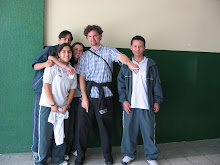Hola panas,
We discussed a lot of interesting and creative ways to assess students in our methods class that were outside of the traditional paper and pencil realm. One strategy would be to set up a series of learning stations that require the students to perform a particular function of the unit. Students would continue to go through the series of stations while the teacher assesses students one at a time in a final station that synthesizes content from all of the stations.
I don't know exactly how we would facilitate this assessment process, but the idea sounds pretty interesting and more useful for promoting proficiency and competency in foreign language. Any suggestions?
El Profe
viernes, 13 de marzo de 2009
martes, 10 de marzo de 2009
Word Walls
Hola amiguitos,
I read about a pretty useful strategy today called "Word Walls". This strategy involves placing a variety of common, interconnected or thematic words on the wall of the classroom for students to refer to during reading, writing, and speaking activities. Once the words are on the wall in Spanish, students cannot say them in English. I would like to do this right away for common word such as: please, thank you, you're welcome, and bless you.
I would also use this strategy to show the relationships between verb conjugations or to list important vocabulary for the current unit.
This strategy would work in a lot of classes to explain concepts and define complicated words.
Inténtalo! (Try it!)
El Profe
I read about a pretty useful strategy today called "Word Walls". This strategy involves placing a variety of common, interconnected or thematic words on the wall of the classroom for students to refer to during reading, writing, and speaking activities. Once the words are on the wall in Spanish, students cannot say them in English. I would like to do this right away for common word such as: please, thank you, you're welcome, and bless you.
I would also use this strategy to show the relationships between verb conjugations or to list important vocabulary for the current unit.
This strategy would work in a lot of classes to explain concepts and define complicated words.
Inténtalo! (Try it!)
El Profe
lunes, 9 de marzo de 2009
Refranes (Hispanic Proverbs)
I saw my cooperating teacher do a really interesting activity today that got the students thinking in both English and Spanish. Using a Powerpoint presentation she first introduced to students to the concept of a Refran (which is essential a Hispanic proverb). She then showed the students a Refran and asked them to figure out what if meant in Spanish. Once the students had a good idea what it meant, she asked them figure out what the English/American version would be. Students were very engaged and interested throughout the activity. This is something that could be done at the beginning of class once or twice a week to help students understand Hispanic Culture and to get them to think more in depth about both cultures.
El Profe
El Profe
miércoles, 4 de marzo de 2009
Interpersonal speaking the easy way
Hola amiguitos!
At LHS I use a very simple strategy for interpersonal speaking practice that is easy to set up and can be done on a daily basis. Students write in their "diarios" at the beginning of each class and respond to a series of prompts. Each day we try to give them a new prompt that will review the previous day's lesson or prepare them for the upcoming lesson. Once they have written the prompt I ask them to share what they wrote with their neighbor. I give them about 1 minute to share then I ask individual students what they wrote. By this time students have had a chance to practice what they are going to say and are therefore more confident when speaking in front of class.
I also use this strategy to practice anything from tongue twisters to dialogue. It's like a mini think pair share that has become a regular feature of my class. I wish I had known about this one in my A placement.
El Profe
At LHS I use a very simple strategy for interpersonal speaking practice that is easy to set up and can be done on a daily basis. Students write in their "diarios" at the beginning of each class and respond to a series of prompts. Each day we try to give them a new prompt that will review the previous day's lesson or prepare them for the upcoming lesson. Once they have written the prompt I ask them to share what they wrote with their neighbor. I give them about 1 minute to share then I ask individual students what they wrote. By this time students have had a chance to practice what they are going to say and are therefore more confident when speaking in front of class.
I also use this strategy to practice anything from tongue twisters to dialogue. It's like a mini think pair share that has become a regular feature of my class. I wish I had known about this one in my A placement.
El Profe
lunes, 2 de marzo de 2009
El periódico
After talking with some MTE classmates about their newspaper projects in Social Studies class, I started thinking about doing something similar in my advanced Spanish classes. When I got to school today I mentioned it to my cooperating teacher then she took out a book that has preplanned ideas for making a newspaper in Spanish. I will probably pick and choose the ideas I want from the book and then modify them to fit our current lessons. The students will also be able to use Microsoft publisher to make a really slick presentation. We'll probably start this project after Spring Break. Any suggestions or ideas?
El Profe
El Profe
Suscribirse a:
Entradas (Atom)

